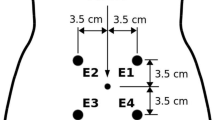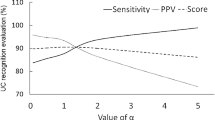Abstract
OBJECTIVE: To determine whether analysis of the frequency or regularity of uterine contractions can distinguish between women delivering vaginally and women requiring Cesarean section for dystocia.
STUDY DESIGN: This was a case–control study. Cases meeting the following criteria were identified: nulliparous women in spontaneous labor, singleton pregnancy, cephalic presentation, 37 to 42 weeks' gestation, Cesarean section for dystocia, a minimum of three analyzable hours of electronically archived cardiotocograph (CTG) prior to onset of the second stage. Cases delivered by Cesarean section for dystocia were each matched with two controls delivering vaginally. The peak of each contraction was visually identified and electronically marked on each CTG trace. A moving average (MTIME) and standard deviation (SDTIME) of five interpeak times were calculated for successive 30-minute periods and plotted against cervical dilatation for each group.
RESULTS: Overall, both MTIME and SDTIME fell as labor progressed, with these changes being more marked in the vaginal delivery group. In women requiring oxytocin, the rate of fall of MTIME and SDTIME was significantly greater following oxytocin in the group which subsequently delivered vaginally (slope of MTIME −2.71 pre-oxytocin and −28.95 post-oxytocin, p=0.0004; slope of SDTIME −0.44 and −6.44, p=0.0002). No such change was seen in the Cesarean section group.
CONCLUSION: As normal labor progresses, there is a shortening of the intercontraction interval and an increase in contraction regularity. A successful response to oxytocin augmentation may be predicted by the change in contraction pattern following treatment.
This is a preview of subscription content, access via your institution
Access options
Subscribe to this journal
Receive 12 print issues and online access
$259.00 per year
only $21.58 per issue
Buy this article
- Purchase on Springer Link
- Instant access to full article PDF
Prices may be subject to local taxes which are calculated during checkout




Similar content being viewed by others
References
Nair C . Trends in Cesarean section deliveries in Canada Health Rep 3: 1991 3: 203–19
National Center for Health Statistics. Detailed diagnosis and procedures, National Hospital Discharge Survey Vital Health Stat 1987 13: 100 1–304
Lindgren L . The influence of uterine motility upon cervical dilatation in labor Am J Obstet Gynecol 1973 117: 530–6
Lindmark G, Nilsson BA . A comparative study of uterine activity in labour induced with prostaglandin F2 alpha or oxytocin and in spontaneous labour: II. Characteristics of uterine activity and their effect on the progress of labour Acta Obstet Gynecol Scand 1977 56: 87–94
Ferreira CJ, Odendaal HJ . Does coupling of uterine contractions reflect uterine dysfunction? S Afr Med J 1994 84: 1 20–5
Steer PJ, Carter MC, Beard RW . Normal levels of active contraction area in spontaneous labour Br J Obstet Gynaecol 1984 91: 211–9
Effer SB, Bertola RP, Vrettos A, Caldeyro-Barcia R . Quantitative study of the regularity of uterine contractile rhythm in labor Am J Obstet Gynecol 1969 105: 909–15
Caldeyro-Barcia R, Sica-Blanco Y, Poseiro JJ, Gonzalez-Panizza V, Mendez-Bauer C, Fielitz C, Alvarez H, Pose SV, Hendricks CH . A quantitative study of the action of synthetic oxytocin on the pregnant human uterus J Pharmacol 1957 121: 18–31
Bidgood KA, Steer PJ . A randomized control study of oxytocin augmentation of labour: 2. Uterine activity Br J Obstet Gynaecol 1987 94: 518–22
Jacobson JD, Gregerson GN, Dale PS, Valenzuela GJ . Real-time microcomputer-based analysis of spontaneous and augmented labor Obstet Gynecol 1990 76: 755–8
Chua S, Kurup A, Arulkumaran S, Ratnam SS . Augmentation of Labor: Does internal tocography result in better obstetric outcome than external tocography? Obstet Gynecol 1990 76: 2 164–7
Author information
Authors and Affiliations
Rights and permissions
About this article
Cite this article
Oppenheimer, L., Bland, E., Dabrowski, A. et al. Uterine Contraction Pattern as a Predictor of the Mode of Delivery. J Perinatol 22, 149–153 (2002). https://doi.org/10.1038/sj.jp.7210622
Published:
Issue Date:
DOI: https://doi.org/10.1038/sj.jp.7210622



